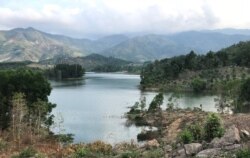Golf, hardly a traditional Vietnamese pastime, is growing in popularity here, a reflection of changing Vietnamese culture and the country's evolving approach to attracting tourists.
A golf driving range now sits among the durian stores and seafood restaurants on some of Ho Chi Minh City’s prime real estate, just outside of downtown. It sticks out like a sore thumb because it is part of a pastime still limited to a small minority of Vietnamese.
However, there are now more than 50 full golf courses in Vietnam. The sport's increasing popularity is an indication not merely of changes in the economy, but in society more broadly — it shows a change in how Vietnamese do business, spend their leisure time, and attract tourists.
Such is the growing popularity of the sport that there is now a trade publication, Vietnam Golf Magazine. This month the magazine quoted Nguyen Thi Thu Ha, vice secretary of the Vietnam Golf Association, on her organization’s latest tournament, focused on women.
“This event will definitely help bring attention to the female golf trend in Vietnam,” Thu Ha said, “each mother, each sister will be inspired so more female golfers can pick up a club and confidently step onto the golf course.”
Golf is dominated by men, as has been the case around the world, including next door in China. However, Chinese President Xi Jinping’s anti-corruption crackdown has made officials cautious about indulging in too much display of opulence, which includes not only luxury watches and designer clothes, but golf as well. Consequently, as multinational golf companies, such as Australia's Pacific Coast Design, look for customers in new markets, one of the places they have landed is Vietnam.
The environmental impact of all these new golf courses, such as overuse of water, pesticides, and natural habitats, as well as the microplastics that golf balls release into the ocean, comes up from time to time, but more often Vietnam focuses on the business opportunity. This month the Conde Nast Traveler Readers’ Choice Awards included Vietnam’s golf and beach resort Laguna Lang Co, near the central city of Hue, among their top picks in Asia.
“Not only is it a boost for tourism in general in central Vietnam, it’s also really good news for golf tourism in this part of the country,” Adam Calver, director of golf at the resort, said.
Golf resorts in Vietnam attract a mix of visitors, including chambers of commerce hosting member events, charity organizations raising money, and the rapidly growing ranks of the new rich looking for a new hobby. The growth rate in the number of super-rich in Vietnam was one of the highest rates in the world in 2017.
Executives are also doing business differently. It used to be that businessmen in Vietnam — and they were primarily men, as women were often excluded — would agree on business deals over many rounds of late-night beers and bar girls. It is a culture seen in South Korea and Japan, too, although many businesses in Japan are trying to change this culture of after-work drinking binges, which are often mandatory for employees. More businessmen in Vietnam now, however, are making deals over rounds of golf instead of beer.
Vietnam also sees golf as a way to diversify its offerings to bring in more foreign tourists.
“In terms of tourism, Vietnam remained an attractive destination for tourists with 12.9 million international visitors in the first nine months of 2019, an increase of 10.8%” annualized, the Vietnam unit of Jones Lang LaSalle, a commercial real estate services firm, wrote in a market analysis.







